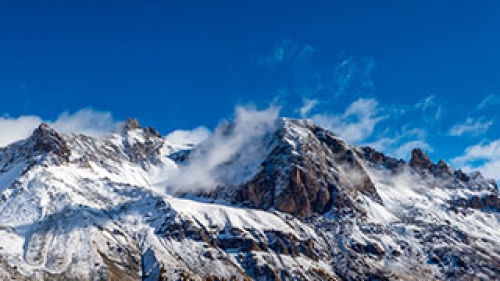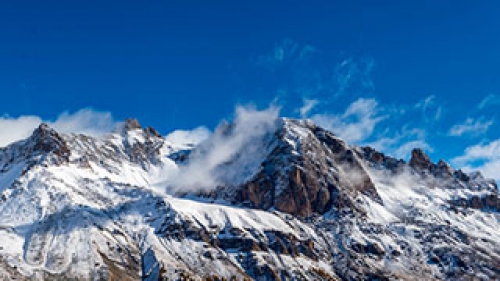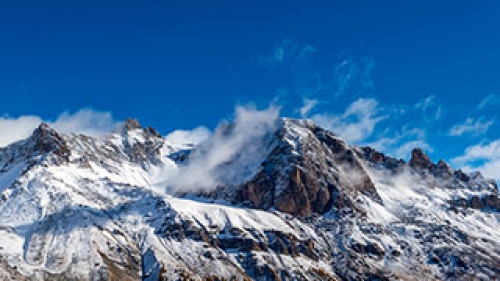
Sikkim - The Home of Glaciers
The State of Sikkim is legendary for its peaceful nature and simplicity. Long sequestered in the Himalaya. The kingdoms of Nepal in the west Bhutan in the east lies a small stretch of rugged land just 115km. by 65 km. the Indian state of Sikkim. On its northern border towers the plateau of Tibet whereas it shares its southern border with West Bengal which is another state of India. On the world map it is approximate latitude of 27 degrees north and longitude of 88 degrees east but its small size of 7094sq km. belies its richness of culture, customs, heritage, flora and fauna.
No wonder Sikkim is a bio-diversity hotspot, Sikkim has only 0.2persent of the area of India but has 26 percent of its biodiversity species of flora and fauna, wild animals like marmots and the red panda, a wide range of flora from primulas to orchids. More then 580 varieties of orchids, over 600 species of butterflies, 552 species of birds. The pristine unspoilt netural beauty include alpine landscape and thick luxuriant tropical forest, rivers in torrents and peaceful lakes a true Shangrila and a veritable kaleidoscope. Sikkim has a very rugged and formidable topography and flat lands are difficult to come by from the air Sikkim looks as though someone has run a giant plough through the land.
Must visit places around Sikkim
Changu Lake/ Tsomgo Lake
A lake at 3753meters impossible you eill say but it is a fact. Changu Lake is 38kms. From Gangtok on the Gangtok Nathula High Way which forms a part of the old trade route from India to China. Before 1962, caravans of mules carrying goods used to ply on this rout. Tsomgo LakeThe road has less gradient and the vegetation adopts an alpine nature. Changu LakeAbout a kilometre ahead of Kyongnosla and about five minutes walk from the road side is the Tseten Tashi cave which is about twenty feet high and so named after a naturalist of Sikkim who was also the private secretary of the Chogyal.
Changu Lake is cool placid water harmonises with the scenic beauty around which is doubled by its reflection in the lake. A small temple of Lord Siva is constructed on the lake side. Primula flowers and other alpine vegetation grow around the lake, which has an average depth of 15 meters, lend a pristine beauty to this place. During the winter months the lake becomes frozen. The lake itself derives its water from the melting snow on the mountain around. During the olden times lamas used to study the colour of the water of the lake and forecast the future. If the waters of the lake had a dark tinge it foreshadowed a year of trouble and unrest in the state. The lake has a few rainbow trout and if you are lucky you may catch a glimpse at them.
Changu Lake which is hardly 20kms. Away from the famous Nathula Pass and about 400 kms. From Lhasa, falls in the restricted area and hence an Inner Line permit , which can be obtained from the Police through the Tourism Department Of Sikkim is required by visitors to visit this place, Foreign Nationals are also permitted to visit the lake.
Baba Mandir
This temple lies on the road between the Nathula and Jelepla Pass. There is a touching story behind the establishment of the temple. Harbhajan Singh was a soldier in the Punjab Regiment. In October 1968 while escorting a column of Baba Mandirmules carrying provisions he fell into a stream and drowned. A few day latter he appeared in the dream of colleague of his and expressed a desire that a monument in his memory be built. His colleagues in the regiment considered the dream to be auspicious and felt that if they fulfilled his desire he would protect them from aggression and mishap. The temple was built and has over the years acquired the status of a place of pilgrimage. Visitors leave a bottle of water which they then arrange to collect a few days latter. It said that drinking the water is wish-yielding.
Nathula Pass
Nathula at 4320meters (14400ft) remained as the major Pass connecting Sikkim to Tibet till 1962. It was through this pass that trade between the ywo countries used to be carried out with trains of mules carring wool, gold, rock salt and borax and taking back essential items of daily use from India. From Nathula yathung the erstwhile famous trade post in the Chumbi Nathula PassValley in Nathula Pass Tibet is just 30 kms. Away. During the clear weather the road winding down the Chumbi Valley can early be seen and on the eastern horizon looms the Chomolhari peak that is situated in Bhutan. The Chinese soldiers are also visible a few metres away from the barbed wire that makes the border between the two countries. The exchange of mail taken place every Thursday and Sunday with the Indian post man crossing over to the Chinese out post and meeting his counterpart to carry out the transaction. An engraved ston also known as the Nehru stone marks the visit of the Late Prime Minister of India Jawarlal Nehru to Nathula in 1958. The Nathula border was quite during the Indo China war in 1962. In 1967 there was a major confrontation in which many lives on both side lost. A memorial has been built in honour of the Indian Soldiers who lost their lives in this battle. The trade route through Nathula was reopened on 6th july 2006 for a few items. The Nathula Pass can be visited by Indian tourists only on selected four days a week.
Pelling
Pelling is a town in the district of West Sikkim, India. Pelling is nestled at an altitude of 2,150 m (7,200 ft). The town is located at a distance of 10 km from the district headquarters of Geyzing. Pelling a scenic tranquil but rapidly awelling hamlet in Sikkim. Pelling become a famous tourist destination for magnificent snow caped mountain view till as recently as 1995, Pelling Pelling nondescript Pellingvillage with a few hous. Apart from Mount Kanchendzunga, pelling provides some of the best views of other mountain like Kokthang, Rathong, Kabru Dom, Shimvo and siniolchu all over 20,000ft. Pelling is an ideal place for tourist, situated on top of the ridge overlooking valley and mountains.
Old monasteries, waterfalls, shot trek rout, villages. Pelling is an important destination in West Sikkim, several mordan and international standard hotels and resort have been created in around Pelling. These Hotels and Resort offer luxurious stay.
Namchi
The word Tinchuley Namchi, Namchi is situated at an altitude of 1,675 m (5500 feet) above sea level. Namchi is deistic head quarter of South. It is situated at a distance of 92 km from the state capital Gangtok literally translating as 'top of the sky' is the fast emerging as a tourist destination. Set in a picturesque location, Namchi offers an unmatched view of the Khangchendzonga Namchirange and the Rangit valley. Here you can visit the Sherdup Choeling Monastery and the Dichen Choeling monastery. Around two kms from Namchi is the old Ngadak monastery which is now being renovated. Situated on a hill just above Ngadak monastery is the very attractive Rock Garden, which is full of rare flowers and plants and also offers breathtakingly beautiful views. Namchi hosts the very popular Namchi Mahotsav, a Tourism, Culture and Food Festival, every year in October. A flower festival is also held annually.
Namchi The 135 feet high statue of Guru Padamasambhava is present at Samdruptse near Namchi at a distance of 75 kms from Gangtok. Samdruptse literally means 'wish fulfilling hill' in the Bhutia language. A unique, awe inspiring and gigangtic 135 feet high statue of Guru Padamasambhava is installed atop Sampruptse. It is the highest statue of Guru Padamasambhava in the world. His Holiness the Dalai Lama laid the foundation stone of the statue in October 1997. It took nearly three years to complete the statue. There is also the Namchi Rock Garden located between Namchi town and Samdruptse. This popular garden has many attractive plants, flowers and species of trees. A number of waiting sheds, view points and waterbodies along its footpaths have been provided. A neat and clean cafeteria serves the tourists and visitors well.
Yuksom
The tranquil little village and surrounding of Yuksom offer ample opportunity for experiencing the history of Sikkim. Yuksom situated 119kms from present Capital Gangtok and 34kms. From Pelling. Yuksom is a large village with a total area of 812.16 hectares (2,006.9 acres) situated at an average altitude of 1780 m. Introduction of Buddhism to the state from Tibet is as Yuksom early as in the 9th century. In the struggle for power between the "Yellow hats" and the "Red hats" in Tibet, the latter had migrated to Sikkim and converted the mild mannered Lepchas (the aboriginal inhabitants) to Buddhism. In the 13th century, relations between Sikkim and Tibet were cemented by a "Brother hood treaty" signed between the Lepcha chief Thekong Thekand Tibetan prince Khe-Bhumsa at Kavi, in north Sikkim. 1641, Lama Lutsum Chembo holy monk travelled from Tibet to Denjong (meaning hidden country) now known as Sikkim to propagate the Buddhist religion.
Gangtok
Gangtok is the capital and largest town of the Indian state of Sikkim. Gangtok is located in the eastern Himalayan range, at an altitude of 5,800 feet (1,800 m) and covers an area of 2.54 square km. The town's population of 98,658 belongs to different ethnicities such as Nepalis, Lepchas and Bhutia, Gangtok is at the centre of Sikkim's tourism industry. In 1894, Thutob Namgyal, the Sikkimese monarch under British rule, shifted the capital from Tumlong to Gangtok, increasing the city's importance. Gangtok A new grand palace along with otherGangtok state buildings was built in the new capital, In 1975, after years of political uncertainty and struggle, including riots, the monarchy was abrogated and Sikkim became India's twenty-second state, with Gangtok as its capital after a referendum. There are densely forested regions around Gangtok, consisting of temperate, deciduous forests of poplar, birch, oak, and elm, as well as evergreen, coniferous trees of the wet alpine zone. Orchids are common, and rare varieties of orchids are featured in flower shows in the city. Bamboos are also abundant. In the lower reaches of the town, the vegetation gradually changes from alpine to temperate deciduous and subtropical. The beauty painted Pagoda-like wooden house, whipping prayer flags, Lamas spinning wheels, views of snow cover peaks and smiling faces of the local people will make you understand that you have entered in to mystic town Gangtok.
Best Deal For Your Holiday
Get in touch and get the best planned trip for you alongwith car rental, hotel booking.
+91 87688 41510 / +91 95478 60049 Contact Us Now







